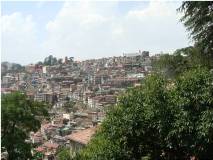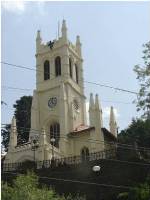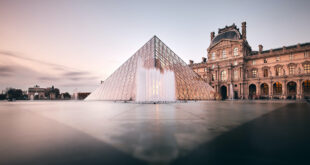As an alternative to the direct route home from Tashkent, we decided to travel to Delhi and, from there, visit Shimla, in the foot-hills of the Himalayas. And so we found ourselves in a hot, over-crowded terminal in Delhi at 3 00 am, mightily relieved we had opted to wait a day before catching two trains to Shimla.
The city is the capital of Himachel Pradesh and is famous in English history as the former summer capital in the days of the British Raj. It is said that about a fifth of the world’s population was ruled from there for about five months of every year. As a result of the British wish to escape the high temperatures of sea-level India. It is built over seven hills and, as a result of British “occupation” has a range of architectural styles. Our guide told us that there is a permanent population of about 170000 and is visited by thousands of tourists each year. To us, if the reportedly growing “spending class” of India has reached 300 million, many of them seemed to be visiting Shimla while were there!
After a day’s sightseeing in Delhi, we were taken to the extremely busy Delhi railway station to catch the Shatadbi express to Kalka, where we were to catch the “toy train” to Shimla.
The express provided an extremely pleasant ride – a rose for each passenger in our car, a series of breakfast dishes – and a cacophony of loud cell-phone conversations. India seems to have embraced the cell phone with huge enthusiasm and most people seemed to be talking on them – and with their companions concurrently!
We have always found the train a great way to see India. This was more comfortable than the others we have used and would be at least as good as many of Europe’s trains. But we had a rude awakening when we reached Kalka!
I had sort of known that the “toy train” was somewhat rudimentary, thanks to Youtube and guide-books. But I think we were both a little unprepared for the uncomfortable bench seats in our very crowded carriage. Add to the crowds, the noise of people jostling for seats and somewhere to store luggage – and the heat! Delhi was 45 degrees and Kalka probably about the same.
The train consisted of about ten carriages and a noisy diesel. We were about two cars from the locomotive and, thanks to open doors and windows, were constantly aware of the sound of the diesel and its horn. The latter sounded as we approached every of the 100 plus tunnels and the many sharp curves. The route was only 96 kilometres but it was scheduled to take 5 and a half hours to travel to Shimla over the “two-foot six-inch” gauge. (New Zealand’s gauge is three-foot, six inches.
To gain altitude from Kalka’s 700 metres above sea level to Shimla’s 2000 metres plus, height, the line has many steep grades – which the locomotive attacked with increased revving – and transverses over itself a number of times. Nor was the country as empty as we expected. Many houses and apartment blocks could be seen on ridge tops and terraced slopes. The state did not seem to be short of vacation accommodation.
Even a train enthusiast as I am found the trip tiring. I probably found it considerably more interesting than Leith and I tried to bury feelings of guilt over this. Her words of “you owe me!” stated as we climbed out of the train still haunt me!
 Our hotel , the Combermere, was one of many buildings on the side of the very steep hill on which the main business area of Shimla was built. A lift provided easy access to The Mall, said to be on of the longest shopping streets in the world. Our room and the dining area looked out over one of the several hills on which Shimla is built. The bottom of the valleys seemed to be more than a 1000 metres below. We had a balcony but a sign warning us against monkeys – a potentially dangerous pest throughout this part of India – meant we hardly used it.
Our hotel , the Combermere, was one of many buildings on the side of the very steep hill on which the main business area of Shimla was built. A lift provided easy access to The Mall, said to be on of the longest shopping streets in the world. Our room and the dining area looked out over one of the several hills on which Shimla is built. The bottom of the valleys seemed to be more than a 1000 metres below. We had a balcony but a sign warning us against monkeys – a potentially dangerous pest throughout this part of India – meant we hardly used it.
If we had to describe what we most liked about Shimla it would be the ambience. The British Raj left behind some wonderful buildings, many of which were still in use but, sadly, in varying states of disrepair. But The Mall and The Ridge, the street above The Mall was a fascinating shopping area for much of its length – few of the shops could be called modern and some – notably one book shop – were fascinatingly shabby.
 Views between the buildings showed us steep steps to other buildings barely clinging to the steep hill side. Some of the buildings were made of stone – the most notable of which was the Gaiety Theatre, which the Brits had built as an entertainment venue. It has just been refurbished to as it was in its heyday and some readers may recall seeing Michael Palin “treading the boards” in his Himalaya series. We never tired of walking the usually crowded areas, the people as interesting to watch as was the architecture.
Views between the buildings showed us steep steps to other buildings barely clinging to the steep hill side. Some of the buildings were made of stone – the most notable of which was the Gaiety Theatre, which the Brits had built as an entertainment venue. It has just been refurbished to as it was in its heyday and some readers may recall seeing Michael Palin “treading the boards” in his Himalaya series. We never tired of walking the usually crowded areas, the people as interesting to watch as was the architecture.
One prominent building we inspected was Christ Church, which is on The Ridge and is a pivotal point of the inner city. We will remember it for the stained glass windows, the vestibule’s smell of old shoes (footwear had to be removed) and the number of brass plaques commemorating Britons who had died in various “foreign fields”.
A day-long 4wd tour showed us more of suburban Shimla but, because of the haze, not the Himalayas. But we did see a privately-run zoo, complete with snow leopard and bears. And the golf course created for Lord Curzon and his chums. But it will be central Shimla we will always picture when we think of this trip.
The trip back to plains and the Chandigargh airport for our return to Delhi and our flight out of India was by comfortable 4wd car. It was a marked contrast to the train but nowhere as interesting to this train “nutter”! Even if it only took four hours!
Shimla will rank high in our list of favourite places!
Courtesy of Footplate










Join the Discussion
Type out your comment here:
You must be logged in to post a comment.